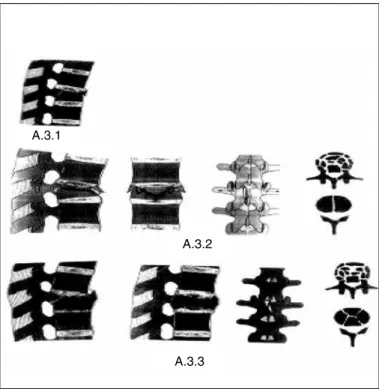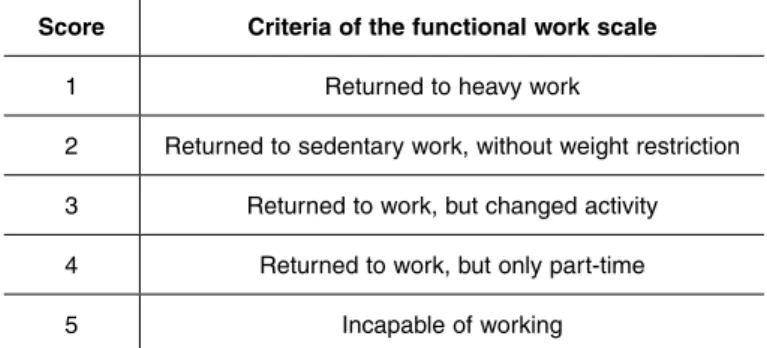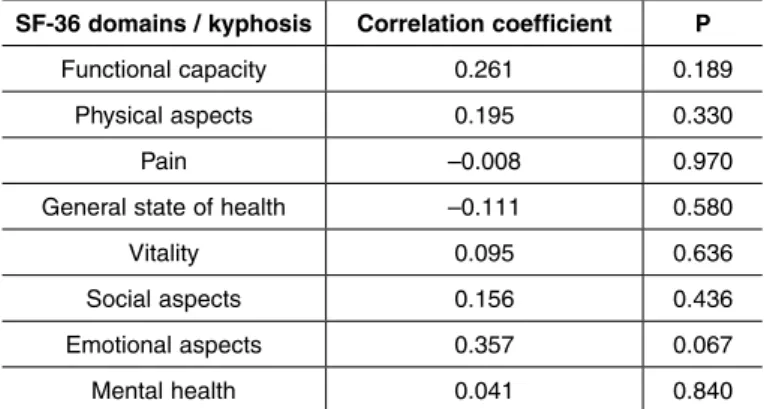11 artigo 595
ORIgINAL ARtICLE
1 – Resident in the Department of Orthopedics and Traumatology, School of Medical Sciences, Santa Casa de Misericórdia de São Paulo (SCMSP), São Paulo, SP, Brazil. 2 – Attending Physician in the Spine Group, Department of Orthopedics and Traumatology, School of Medical Sciences, Santa Casa de Misericórdia de São Paulo (SCMSP),
São Paulo, SP, Brazil.
3 – Head of the Spine Group, Department of Orthopedics and Traumatology, School of Medical Sciences, Santa Casa de Misericórdia de São Paulo (SCMSP), São Paulo, SP, Brazil.
4 – Director of the Department of Orthopedics and Traumatology, School of Medical Sciences, Santa Casa de Misericórdia de São Paulo (SCMSP), São Paulo, SP, Brazil. Work performed by the Spine Group of the “Fernandinho Simonsen” Wing of the Department of Orthopedics and Traumatology, School of Medical Sciences, Santa Casa de Misericórdia de São Paulo (SCMSP).
Correspondence: Robert Meves, Rua Dr. Cesário Mota Jr., 112 – 01277-900 – São Paulo, SP, Brazil. E-mail: robertmeves@hotmail.com Work received for publication: September 27, 2011; accepted for publication: November 21, 2011.
THORACOLumBAR BuRST FRACTuRE: CORRELATION BETWEEN
kYPHOSIS AND FuNCTION AFTER SuRgICAL TREATmENT
Daniel Akira Sadatsune1, Pedro Pereira da Costa1, Maria Fernanda Silber Caffaro2, Ricardo Shigueaki Umeta2,
Robert Meves3, Osmar Avanzi4
ABstRACt
Objective: To assess the correlation between post-traumatic kyphosis in patients with thoracolumbar burst fractures undergoing surgical treatment and the functional result from treatment. Methods: A retrospective study was conducted on 27 patients with thoracolumbar burst fractures according to Denis and A3 to Margerl’s classification who met the inclusion criteria for this sample and underwent surgical treatment with a minimum follow-up of six months. The patients’ mean age was 46.96, with a range from 16 to 73 years. The treatment outcome was evaluated based on applying the
INtRODUCtION
Thoracolumbar burst fractures result from axial compression with rupture of the anterior and medial structures of the vertebral body, with retropulsion of a bone fragment into the spinal canal and an increase in the interpedicular distance. This region is a common site for injuries, with frequencies ranging
from 10 to 45%(1-3).
This type of injury occurs frequently in young individuals of productive age and results from hi-gh-energy trauma. It may be associated with other injuries, such as fractures at other levels of the spi-ne, or in limbs or the pelvis, and chest and abdo-minal injuries(4).
Around 90% of all spinal fractures occur between T11 and L4, and around 14 to 17% are classified as burst fractures. This region is sensitive to injury
for three reasons: loss of the stabilization provided by the ribs and thoracic musculature; the transition from kyphotic thoracic curvature to lordotic lumbar curvature; and the change in orientation of the joint facets from coronal in the thoracic spine to sagittal in the lumbar spine(4).
Thoracolumbar burst fractures can be classified using the AO method, as originally described by
Magerl et al(5). Type A comprises axial compression
fractures affecting the vertebral body. Subtype A1 includes fractures with impaction of spongy bone without fragmentation, subtype A2 includes fractu-res with sagittal or coronal shearing and subtype A3 consists of cases of partial or total comminution with or without retropulsion of fragments to the spinal ca-nal. Subtype A3 can also be stratified as A3.1, com-prising incomplete burst fractures; A3.2, burst with
The authors declare that there was no conflict of interest in conducting this work
this article is available online in Portuguese and English at the websites: www.rbo.org.br and www.scielo.br/rbort
short-form 36 (SF-36) quality of life questionnaire, Denis pain and work scale and visual pain scale. The kyphosis was measured according to the Cobb method at the end of the follow-up. Results: The residual kyphosis was found not to correlate with the SF-36, Denis pain and work scale or visual pain score (p > 0.05). Conclusion: There is no correlation between the final clinical result and residual kyphosis in patients with thoracolumbar burst fractures who undergo surgical treatment.
shearing; and A3.3, complete burst (Figure 1). Type B consists of fractures due to flexion-distraction, and type C consists of any fracture mentioned above with
a superimposed rotational component(1,5).
Some patients with burst fractures develop progressive mechanical instability, characterized by increased
kyphosis, back pain and neurological sequelae(7,8).
Unstable fractures with kyphosis > 30°, height loss > 50%, compression of the spinal canal > 50% and associated neurological deficits generally pre-sent an indication for surgical treatment, according
to most authors(9). However, for thoracolumbar burst
fractures without signs of instability and with normal neurological examinations, there are divergences re-garding the treatment method. Authors who advocate a surgical procedure affirm that this provides better correction of kyphosis, thereby diminishing pain and future degenerative alterations; prevents neurological deterioration and recurrence of the deformity; and reduces the duration of immobilization, resting and hospital stay(10-13).
Recurrence of kyphosis following surgical treat-ment of this type of fracture has already been reported in the literature. Its frequency is correlated with the type of surgery performed, the initial kyphosis and the reduction in the height of the vertebral body. Moreover, it occurs more frequently in patients who have
under-gone removal of the synthesis material(14) (Figure 2).
Figure 1 – magerl classification(6).
Figure 2 – Long-term postoperative result from thoracolumbar fracture, showing evo-lution with residual kyphosis.
OBJECtIVE
The aim of this study was to evaluate the correla-tion between recurrence of kyphosis and funccorrela-tion, in patients who underwent surgical treatment of thora-columbar burst fractures.
MAtERIALs AND MEtHODs
A retrospective cross-sectional study was conduc-ted at the Department of Orthopedics and Traumato-logy, Santa Casa de Misericórdia de São Paulo. All the medical files from patients with thoracolumbar burst fractures hospitalized between 1991 and 2010 were retrieved from the Medical Archive and Statis-tics Service (SAME).
Patients with burst fractures as defined using the Denis criteria and Magerl classification of subtype
A3(5) who had been followed up for at least six months
and who responded to a recall for clinical reassessment were included in this study, by means of questionnai-res and radiographs.
Cases without complete documentation (medical files and radiographs), patients who did not respond to the recall, patients with pathological fractures and victims of firearm wounds were excluded. Patients admitted more than 10 days after the date of the frac-ture (late fracfrac-tures) were also excluded.
The patients were evaluated based on the Short
A.3.1
A.3.2
Form 36 (SF-36) quality-of-life questionnaire(15), in
its version validated for the Portuguese language.
The Denis work and pain scales were also applied(1)
(Tables 1 and 2).
Measurements of kyphosis were made in
accordan-ce with the Cobb method(16), after producing
lateral--view radiographs of the segment affected, at the time of the recall for applying the questionnaire.
For the statistical analyses of this study, the signi-ficance level was taken to be 5%. The SPSS software (Statistical Package for the Social Sciences), version 13.0, was used to analyze and produce the results.
Spearman’s correlation analysis was used, with the aim of ascertaining the degree of relationship between the variables of interest, examined pair-by-pair.
Twenty-seven patients fulfilled the inclusion criteria for this study. Their mean age was 46.96 years (ranging from 16 to 73 years), and there were 14 males and 13 females. The trauma mechanism consisted of falling from a height in 23 cases, being run over in two cases, a motorcycle accident in one case and a heavy object falling onto the pa-tient in one case. Regarding the vertebra that was fractured, 11 patients had a fracture in L1, nine in L2 and seven in T12. All of the patients remained free from neurological lesions during the hospital stay (Table 3).
REsULts
In the radiographic evaluation, the mean kyphosis
encountered was 20°, with a range from 0 to 48°.
Regarding pain, five patients were free from pain; 11 presented minimal pain without using medication; 10, moderate pain with occasional use of medication; and one, severe pain with chronic use of medication. Regarding work, eight patients had returned to doing heavy work; six had returned to sedentary work without weight restrictions; nine had returned to work but had changed their activity; two had returned to work part-time; and two remained incapable of working.
No correlations were observed between the residual kyphosis and any of the following: total SF-36 score (p = 0.647), SF-36 domain scores, visual analogue pain score (p = 0.366), Denis pain scale (p = 0.263) or Denis work scale (p = 0.335) (Tables 4 and 5).
DIsCUssION
The treatment for thoracolumbar burst fractures is a matter that is still under discussion. Observatio-nal studies on neurologically intact patients have not shown any differences in the long-term functional results among patients with this type of lesion, inde-pendent of whether they underwent surgical treatment or not(2,3,10). However, the surgical method is generally
proposed for patients whose fractures have led to loss of 50% of the height of the vertebral body and kypho-sis greater than 30°, because of inadequate functional results. The authors who have advocated this type of treatment have used shorter hospital stay and early mobility as arguments in its favor(11,13,17,18).
In the literature, there are still few studies showing any specific relationship between functional results and surgical treatment for thoracolumbar burst
frac-tures. Andress et al(19) conducted a study on a
retros-pective series of 50 patients with burst factures who underwent surgical treatment, and were unable to prove any correlation between the radiographic fin-dings and the patients’ long-term functional results, in relation to pain. In another retrospective study
con-ducted by Lakshmanan et al(14), in which they sought
to correlate recurrence of kyphosis in 26 patients who had undergone surgical treatment, with the functional implications, no statistical correlation could be found. The results from those studies were similar to ours.
To evaluate the quality of life among the patients
table 1 – Functional pain scale according to Denis(1).
score Criteria of the pain scale
1 No pain
2 Minimal pain, without using medication
3 Moderate pain, with occasional use of medication
4 Moderate to severe pain, with constant use of medication
5 Severe pain, with chronic use of medication
table 2 – Functional work scale according to Denis(1).
score Criteria of the functional work scale
1 Returned to heavy work
2 Returned to sedentary work, without weight restriction
3 Returned to work, but changed activity
4 Returned to work, but only part-time
in our study, the SF-36 and visual analogue scale were used. These instruments have been validated for use in our setting and are of great value for analyzing the results from patient-centered treatment that is not just based on radiographic criteria. In the same way as in our findings, the other case series surveyed also showed a lack of evident correlation between kyphosis and spi-nal symptoms or function following surgical treatment. The limitations observed in this study were its retrospective nature , with the inherent difficulty in locating the patients for inclusion in the study (lack of correct addresses and telephone numbers in the da-tabases), the relatively small number of patients and the lack of comparison with patients undergoing con-servative treatment. Other studies with different me-thodologies and statistical designs could be conducted to increase the statistical significance of the results obtained. Nonetheless, the scarcity of information on this subject provided justification for the present study.
table 3 – Distribution of the patients hospitalized between 1991 and 2010.
Patient sex Age Mechanism Level Kyphosis VAs Denis pain Denis work sF 36
1 F 50 Run over L1 19 4 3 2 104
2 m 42 Fall L1 27 6 3 3 74.35
3 m 58 Fall T12 30 1 2 1 137.4
4 F 45 Run over L1 28 7 3 4 95.75
5 F 60 Direct trauma L2 19 0 1 2 139.4
6 m 36 Fall L2 40 3 1 1 128.35
7 m 45 Fall T12 1 2 2 3 119.25
8 m 26 Fall L1 19 8 3 3 75.75
9 F 67 Fall T12 14 5 2 2 112
10 F 61 Fall L1 16 2 2 1 106.25
11 m 59 Fall L2 10 10 5 5 61
12 F 60 Fall L1 28 7 3 3 92.25
13 m 57 Fall T12 18 10 3 4 86.6
14 F 25 Fall L2 24 5 2 3 82.5
15 F 16 Fall L2 0 5 3 3 106.1
16 F 36 Fall T12 14 2 1 2 109.5
17 m 46 Fall T12 30 8 3 3 76.25
18 F 50 Fall T12 8 8 3 2 89.75
19 F 42 Fall L2 13 8 3 5 102.35
20 F 41 Fall L1 23 0 2 1 104
21 m 47 Motorcycle accident L1 36 0 1 3 119.25
22 F 33 Fall L2 14 8 2 2 83
23 m 48 Fall L1 10 1 2 1 117.8
24 m 41 Fall L2 22 5 2 3 115.1
25 m 73 Fall L2 10 2 1 1 137
26 m 52 Fall L1 48 2 2 1 133.8
27 m 52 Fall L1 19 5 2 1 129.25
Legend: age in years and kyphosis in degrees. F = female; M = male; VAS = visual analogue pain scale.
table 4 – Correlation between the SF-36 domains and kyphosis.
sF-36 domains / kyphosis Correlation coefficient P
Functional capacity 0.261 0.189
Physical aspects 0.195 0.330
Pain –0.008 0.970
General state of health –0.111 0.580
Vitality 0.095 0.636
Social aspects 0.156 0.436
Emotional aspects 0.357 0.067
mental health 0.041 0.840
table 5 – Correlation between the variables and kyphosis.
Variable/kyphosis Correlation coefficient P
Pain –0.008 0.970
vAS –0.181 0.366
Denis pain scale –0.223 0.263
Denis work scale –0.193 0.335
SF-36 0.92 0.647
CONCLUsION
No evident correlations were found between resi-dual kyphosis, pain and functional results, as shown on the SF-36 and Denis scales after surgical treatment on patients with thoracolumbar burst fractures of sub-type Denis-A3 without neurological lesions.
ACKNOwLEDgEMENts
We thank the Publications Support Unit of the School of Medical Sciences, Santa Casa de São Paulo (NAP-SC) for technical and scientific support towards publication of this manuscript.
REFERENCEs
1. Denis F. The three column spine and its significance in the classification of acute thoracolumbar spinal injuries. Spine (Phila Pa 1976). 1983;8(8):817-31. 2. Kraemer WJ, Schemitsch EH, Lever J, McBroom RJ, McKee MD, Waddell JP. Functional outcome of thoracolumbar burst fractures without neurological deficit. J Orthop Trauma. 1996;10(8):541-4.
3. Thomas KC, Bailey CS, Dvorak MF, Kwon B, Fisher C. Comparison of operative and nonoperative treatment for thoracolumbar burst fractures in patients without neurological deficit: a systematic review. J Neurosurg Spine. 2006;4(5):351-8. 4. Knight RQ, Stornelli DP, Chan DP, Devanny JR, Jackson KV. Comparison of
operative versus nonoperative treatment of lumbar burst fractures. Clin Orthop Relat Res. 1993;(293):112-21.
5. Magerl F, Aebi M, Gertzbein SD, Harms J, Nazarian S. A comprehensive clas-sification of thoracic and lumbar injuries. Eur Spine J. 1994;3(4):184-201. 6. Delfino HLA. Classificação das fraturas da coluna torácica e lombar. Coluna.
2002:1(1):41-8.
7. Jones RW. Manipulative Reduction of Crush Fractures of the Spine. Br Med J. 1931; 1(3659):300-2.
8. Holdsworth F. Fractures, dislocations, and fracture-dislocations of the spine. J Bone Joint Surg Am. 1970;52(8):1534-51.
9. Domenicucci M, Preite R, Ramieri A, Ciappetta P, Delfini R, Romanini L. Thora-columbar fractures without neurosurgical involvement: surgical or conservative treatment? J Neurosurg Sci. 1996;40(1):1-10.
10. Avanzi O, Chih LY, Meves R, Caffaro MFS, Bueno RS, Freitas MMF. Fratura toracolombar tipo explosão: resultados do tratamento conservador. Rev Bras Ortop. 2006;41(4):109-15.
11. Tezer M, Erturer RE, Ozturk C, Ozturk I, Kuzgun U. Conservative treatment of fractures of the thoracolumbar spine. Int Orthop. 2005; 29(2):78-82. Epub 2005 Feb 16.
12. Shen WJ, Liu TJ, Shen YS. Nonoperative treatment versus posterior fixation for thoracolumbar junction burst fractures without neurologic deficit. Spine (Phila Pa 1976). 2001; 26(9):1038-45.
13. McEvoy RD, Bradford DS. The management of burst fractures of the tho-racic and lumbar spine. Experience in 53 patients. Spine (Phila Pa 1976). 1985;10(7):631-7.
14. Lakshmanan P, Jones A, Mehta J, Ahuja S, Davies PR, Howes JP. Recurrence of kyphosis and its functional implications after surgical stabilization of dorso-lumbar unstable burst fractures. Spine J. 2009; 9(12):1003-9. Epub 2009 Oct 9. 15. Ware JE Jr, Sherbourne CD. The MOS 36-item short-form health survey (SF-36).
I. Conceptual framework and item selection. Med Care. 1992;30(6):473-83. 16. Harrison DE, Cailliet R, Harrison DD, Janik TJ, Holland B. Reliability of centroid,
Cobb, and Harrison posterior tangent methods: which to choose for analysis of thoracic kyphosis. Spine (Phila Pa 1976). 2001; 26(11):E227-34.
17. Gertzbein SD. Scoliosis Research Society. Multicenter spine fracture study. Spine (Phila Pa 1976). 1992; 17(5):528-40.
18. Sanderson PL, Fraser RD, Hall DJ, Cain CM, Osti OL, Potter GR. Short seg-ment fixation of thoracolumbar burst fractures without fusion. Eur Spine J. 1999;8(6):495-500.


